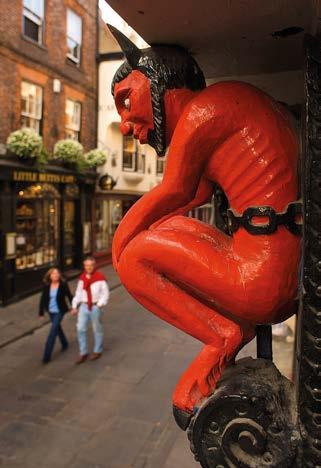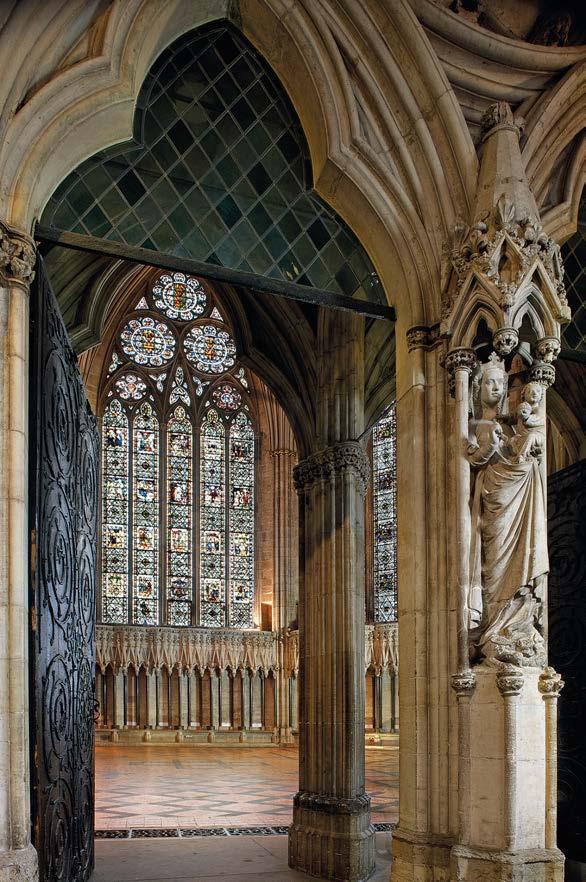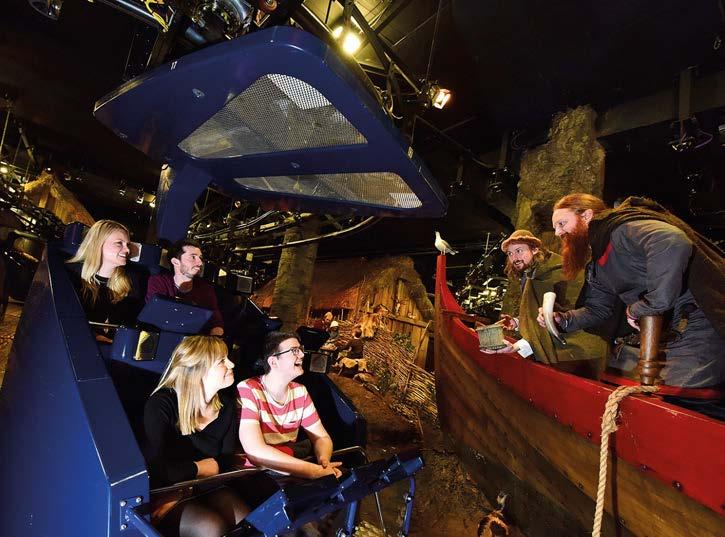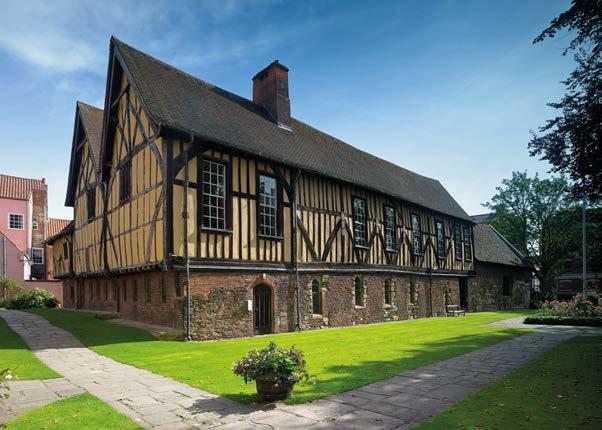
6 minute read
CITY GUIDE: YORK
TOP 10 YORK
From Roman ruins to a magnificent medieval cathedral, a visit to York is a journey through layers of rich and colourful history
WORDS NATASHA FOGES
With medieval alleyways, Roman remains and a Viking treasure trove, York is a history-lover’s dream. Founded as Eboracum by the Romans, called Jorvik by the Vikings and named York by the Normans, the city was the most powerful in northern England by medieval times.
The story begins with the Romans, who in 71 AD established a fortress at Eboracum – ‘the place of yew trees’ – which grew into a great military stronghold facing a town across the River Ouse. York is dotted with Roman relics, and much of the old city remains, buried some six metres beneath the narrow cobbled streets.
The Vikings followed, sailing up the Ouse in 866 and turning the city into an important trading port. The remarkable Coppergate archaeological dig in 1972 unearthed Viking houses, workshops and countless artefacts, now proudly on display in the Jorvik Viking Centre. It was during the Middle Ages that the city’s most stunning architecture was created, from the magnificent Minster to the stonework of the city walls and Clifford’s Tower, all that remains of York’s medieval castle (currently closed for restoration). For a sense of the bustling medieval city, stroll down the Shambles, lined with 14th-century buildings that today house quaint antiques, jewellery and gift shops. Nearby Stonegate, which took its name from the vast quantity of limestone brought up this street for the building of the Minster, once thronged with goldsmiths, glass painters and printers; look out for the red devil on the wall of no.33, the traditional sign of a printer’s shop. You could spend hours exploring the surrounding tangle of narrow medieval alleyways – or ‘snickelways’ as they’re called in York. With so many twists and turns you’re bound to get lost, but what better way to experience this multi-layered city, where every street has its own story to tell?

1The Shambles This cobbled street – one of England’s most-photographed – was once lined with medieval butcher’s shops, whose crookedly overhanging buildings remain. The street was narrow by design, to keep the meat sold here out of direct sunlight; it’s said that two people in buildings on opposite sides of the street can lean across and shake hands. www.visityork.org


2York Minster The jewel in York’s crown is York Minster, the largest Gothic cathedral in northern Europe, built between 1220 and 1472. Highlights are the stained glass (the Minster houses more than half of England’s medieval stained glass in its 128 windows); the vaulted and beautifully carved Chapter House; and the Undercroft, which holds the remains of a Roman barracks. www.yorkminster.org

3Tea at Bettys You can’t visit York without a cup of tea and a slice of cake at the world-famous Bettys Café Tea Rooms. Bettys has been keeping locals supplied with tea and cake since 1919, and its Art Deco interiors are a treat in themselves. For a luxurious afternoon tea, book the Belmont Room, with decor inspired by the Queen Mary ocean liner. www.bettys.co.uk
4National Railway Museum A vintage-style ‘Road Train’ shuttles passengers from York Minster to this excellent museum, packed with iconic trains, from Mallard, the world’s fastest steam locomotive built in the 1930s, to the Shinkansen, a Japanese bullet train. You can also admire the world’s finest collection of royal carriages and hop aboard a miniature railway. railwaymuseum.org.uk


6City Walls York’s marvellous medieval walls encircle the city and offer elevated views through the ancient arrow slits. Visit in springtime for a stunning display of daffodils blooming on the slopes below the walls. www.yorkwalls.org.uk 5 Merchant Adventurers’ Hall Merchants who risked their own money in overseas trade to bring back wealth to York used to gather at this timber-framed guildhall more than 650 years ago – and they still do, as it remains the base for the Company of Merchant Adventurers of the City of York to this day. www.merchantshallyork.org


7Jorvik Viking Centre Built on the site of the Coppergate archaeological dig, Jorvik takes you round 10th-century York, whose sights, sounds and even smells have been painstakingly recreated. There’s also the chance to get up close to some of the world’s rarest Viking artefacts. www.jorvikvikingcentre.co.uk
8Castle Howard Just outside York in the Howardian Hills, Castle Howard makes a rewarding day-trip. Built over 300 years ago by Sir John Vanbrugh, it is still home to the Howard family. With magnificent interiors and sweeping parkland, it’s little wonder that it was chosen as a location for Netflix’s Bridgerton. www.castlehoward.co.uk

10 York Castle Museum Set on the former site of York Castle, this enjoyable museum offers a social history of the city. The highlight is the cobbled Kirkgate, a recreated Victorian street – complete with authentic shop fronts sourced from all over the country. It was built on the former exercise yard of the Georgian prison that once stood here; you can also visit the cells, which once housed the infamous highwayman Dick Turpin. www.yorkcastlemuseum.org.uk 9 Fairfax House York’s higgledy-higgledy medieval streets are in stark contrast to the austere elegance of Georgian York. This 18th-century townhouse, originally the winter home of Viscount Fairfax, has wonderfully preserved interiors: a masterpiece of Georgian design. www.fairfaxhouse.co.uk


THE PLANNER
GETTING THERE AND AROUND There are direct trains to York from London’s Kings Cross station (around 2hr). The city’s compact centre can easily be explored on foot. As the sun goes down ghost walks are a popular activity (after all, York is said to be Europe’s most haunted city). Your Victorian guide, dressed in a top hat and frock coat, will tell hair-raising tales and take you to the city’s most ghoulish spots. www.lner.co.uk; www.ghosthunt.co.uk
WHERE TO STAY The Principal is York’s grande dame, just steps from the train station and an easy stroll into town. Its impressive Victorian architecture (sweeping staircases and soaring ceilings) has been softened with warmly furnished rooms in soothing neutral tones. Or experience a bit of the city’s history first-hand with a stay at the Guy Fawkes Inn, in the shadow of the Minster, where the Gunpowder Plotter was born in 1570. The hotel’s restaurant is atmospherically lit by candles and gaslights. theprincipalyork.ihg.com; www.guyfawkesinnyork.com
WHERE TO EAT AND DRINK Based in the Old Engine House by York’s Museum Gardens, the Star Inn the City offers fine Yorkshire dishes – peppered Thirkleby duck breast with hash browns and braised garden peas, for example – in a scenic riverside location. For a fine-dining treat, book the blind eight-course tasting menu at Le Cochon Aveugle, served in dinner-party style. The culinary flights of fancy of chef Josh Overington make each course a surprise. Josh’s more casual wine bar, Cave du Cochon, is on the same street and has a huge selection of wines by the glass, plus gourmet pizzas and simple plates of cheese and charcuterie. For the sweet-toothed, York’s Chocolate Story is a must. A chocolate-themed tour unwraps York’s long history of the nation’s favourite confectionery, with delicious treats to nibble along the way, and concludes with a chocolate-making session. www.starinnthecity.co.uk; www.lecochonaveugle.uk; www.yorkschocolatestory.com
i
FURTHER INFORMATION www.visityork.org










